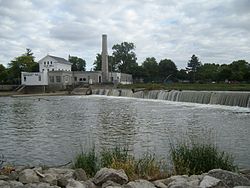- Old Mill Museum (Dundee, Michigan)
-
Old Mill Museum
 Location within the state of Michigan
Location within the state of MichiganLocation: 242 Toledo Street
Dundee, MichiganCoordinates: 41°57′19″N 83°39′33″W / 41.95528°N 83.65917°WCoordinates: 41°57′19″N 83°39′33″W / 41.95528°N 83.65917°W Built: 1849 Governing body: Village of Dundee Part of: Dundee Historic District (#90001239) Significant dates Designated CP: August 20, 1990[2] Designated MSHS: August 3, 1979[1] The Old Mill Museum, also known as the Alfred Wilkerson Grist Mill, is a historic structure located along the River Raisin at 242 Toledo Street in Dundee, Michigan. It was designated as a Michigan Historic Site on August 3, 1979.[1] It was later listed as a contributing property within the Dundee Historic District, which was added to the National Register of Historic Places on August 20, 1990.[2]
Referred to as the oldest and most notable landmark in Dundee, it is the Dundee Historic District's only inclusion (along with the surrounding park) on the opposite of the river from the rest of the downtown area. While the facility itself was not built until the 1849, the dam upon which it is located was first constructed in 1827 and rebuilt in 1846. It is the largest of several dams located along the River Raisin — the majority of which are in nearby Monroe.[3]
The facility first served as a gristmill for the growing milling industry in Dundee. Later, the building was converted to produce hydroelectricity as the village's only source of power around 1910. As the oldest surviving structure in Dundee, it was almost demolished in 1934 after years of disuse. Automotive magnate Henry Ford purchased the building and restored it at great cost as part of his village industries program. His only addition to the original three-story structure was the addition of a single-story structure on the side of the building. He converted the mill into a small factory to produce welding tips for his industry, and he was known to make many visits to Dundee. His interest in Dundee was an experiment to see if small towns could be used for his massive, global industry.[3][4] After Ford's death in 1947, support for this small factory diminished, and it was sold in 1954 to the Wolverine Manufacturing Company, where the building was converted once more to produce paper products. The Wolverine Manufacturing Company used the facility until 1970, when they sold it to the village of Dundee for $1. The village revamped the structure and its surrounding 13.8 acres (5.6 ha) for public use as a museum and park.[5] Although the property is praised for its historical nature, it is not listed on the National Register of Historic Places in its own right.
References
- ^ a b State of Michigan (2009). "Wilkerson, Alfred, Grist Mill". http://www.mcgi.state.mi.us/hso/sites/10452.htm. Retrieved June 26, 2010.
- ^ a b "National Register Information System". National Register of Historic Places. National Park Service. 2008-04-15. http://nrhp.focus.nps.gov/.
- ^ a b Village of Dundee (2009). "The Old Mill". http://www.dundeevillage.net/default.asp?_resolutionfile=templatespath.default.asp&area_2=pages/old_mill/oldmillmainpage. Retrieved November 23, 2009.
- ^ State of Michigan (2001–2003). "Dundee Historic District". http://www.mcgi.state.mi.us/hso/sites/10444.htm. Retrieved November 12, 2009.
- ^ Dundee Internet Service, Inc. (2009). "Old Mill Museum". http://www.dundeeoldmill.com/index.htm. Retrieved November 22, 2009.
National Register of Historic Places in Monroe County, Michigan Historic districts Dundee Historic District | East Elm-North Macomb Street Historic District | North Maumee Bay Archeological District | Old Village Historic District | St. Mary's Church Complex Historic District

Historic properties Detroit River Light Station | Edward Loranger House | George Armstrong Custer Equestrian Monument | Governor Robert McClelland House | Jefferson Avenue-Huron River Bridge | Navarre-Anderson Trading Post | River Raisin National Battlefield Park | Rudolph Nims House | Sawyer House | Weis Manufacturing Company
Contributing properties Old Mill Museum | St. Mary Catholic Central High School
U.S. National Register of Historic Places Topics Lists by states Alabama • Alaska • Arizona • Arkansas • California • Colorado • Connecticut • Delaware • Florida • Georgia • Hawaii • Idaho • Illinois • Indiana • Iowa • Kansas • Kentucky • Louisiana • Maine • Maryland • Massachusetts • Michigan • Minnesota • Mississippi • Missouri • Montana • Nebraska • Nevada • New Hampshire • New Jersey • New Mexico • New York • North Carolina • North Dakota • Ohio • Oklahoma • Oregon • Pennsylvania • Rhode Island • South Carolina • South Dakota • Tennessee • Texas • Utah • Vermont • Virginia • Washington • West Virginia • Wisconsin • WyomingLists by territories Lists by associated states Other Categories:- Historic district contributing properties
- Industry museums in Michigan
- Museums in Monroe County, Michigan
- Buildings and structures completed in 1849
- Victorian architecture in Michigan
- Michigan State Historic Sites
- Ford village industries
Wikimedia Foundation. 2010.


